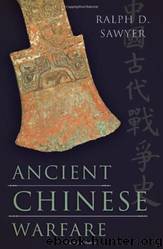Ancient Chinese Warfare by Ralph D. Sawyer

Author:Ralph D. Sawyer
Language: eng
Format: mobi, epub
Tags: Technology & Engineering, Prehistoric, Warfare, Asia, General, China, Military, Military art and science, Military Science, History
ISBN: 9780465021451
Publisher: Basic Books
Published: 2011-03-01T01:49:21+00:00
EARLY CHINESE BOWS
Despite its primal importance in Chinese warfare, there has been a surprising dearth of articles on the bow and arrow. However, from the few attempts,40 numerous archaeological reports, various comments in the classic military writings, passages such as already cited from the Tso Chuan and found in other works including the Shih Ching and the late ritual texts known as the Yi Li and Chou Li, as well as material on early fabrication techniques preserved in the K’ao-kung Chi, a sufficient number of basic historical points can be cobbled together to illuminate archery’s role in ancient Chinese military activities.41 Unfortunately, despite extensive evidence pointing to their existence, no bows have ever been recovered from any early cultural site, and even Anyang has yielded only impressions in the dirt.
Nevertheless, close examination of the characters employed in Shang oracle and bronze inscriptions has led to the generally accepted conclusion that late Shang bows were recurved and therefore necessarily composite in construction, as well as quite powerful.42 (The discovery of numerous water buffalo horns, essential for compressive strength, at Hsiao-t’un provides additional evidence of their composite nature.)43 Based on jade and bronze end fittings with discernible string notches, the position of various bow components in excavations, impressions left in the compacted soil, statements in the K’ao-kung Chi, and recourse to a later realization, Shang and early Western Chou bows are estimated to have been approximately 160 centimeters in length, or slightly less than a man’s height of 160 to 165 centimeters at the time.44 At roughly 60 inches or 5 feet, a bow of this length would have been somewhat shorter than the English longbow as well as far more compact when strung. Unstrung, the tips of the recurved bow were apparently some 65 centimeters apart based on the relative position of end pieces still lying in the ground at Hsiao-t’un.45
Idealized descriptions of distinctive bows carried by the king, feudal lords, lesser nobles, and ordinary warriors suggest that several types existed in the Western Chou and perhaps earlier. According to Hsün-tzu, a late Warring States writer, “That the son of Heaven has an engraved bow, the feudal lords have cinnabar bows, and the high officials have black bows (accords) with the forms of propriety (li).”46 In describing the duties of an official bow maker, the K’ao-kung Chi states: “In making a bow for the son of Heaven, the criteria is for nine layers to be combined; in making bows for the feudal lords, the criteria call for seven layers to be combined; in making bows for the high officials, the criteria call for five layers to be combined; and in making bows for the shih [lower members of the nobility or warriors], the criteria call for three layers to be combined.”
Statements such as these reflect an emerging Warring States, Confucian-derived insistence that gradation that should characterize all social and political relationships, projected back onto the early Chou. (More than substance, sumptuary regulations normally constrained the embellishments and quality of materials such as jade and gold that might be chosen for ceremonial or ostentatious manifestation.
Download
This site does not store any files on its server. We only index and link to content provided by other sites. Please contact the content providers to delete copyright contents if any and email us, we'll remove relevant links or contents immediately.
| Arms Control | Diplomacy |
| Security | Trades & Tariffs |
| Treaties | African |
| Asian | Australian & Oceanian |
| Canadian | Caribbean & Latin American |
| European | Middle Eastern |
| Russian & Former Soviet Union |
The Secret History by Donna Tartt(18852)
The Social Justice Warrior Handbook by Lisa De Pasquale(12143)
Thirteen Reasons Why by Jay Asher(8800)
This Is How You Lose Her by Junot Diaz(6797)
Weapons of Math Destruction by Cathy O'Neil(6148)
Zero to One by Peter Thiel(5691)
Beartown by Fredrik Backman(5600)
The Myth of the Strong Leader by Archie Brown(5428)
The Fire Next Time by James Baldwin(5250)
How Democracies Die by Steven Levitsky & Daniel Ziblatt(5130)
Promise Me, Dad by Joe Biden(5088)
Stone's Rules by Roger Stone(5027)
A Higher Loyalty: Truth, Lies, and Leadership by James Comey(4848)
100 Deadly Skills by Clint Emerson(4843)
Rise and Kill First by Ronen Bergman(4705)
Secrecy World by Jake Bernstein(4652)
The David Icke Guide to the Global Conspiracy (and how to end it) by David Icke(4628)
The Farm by Tom Rob Smith(4439)
The Doomsday Machine by Daniel Ellsberg(4420)
